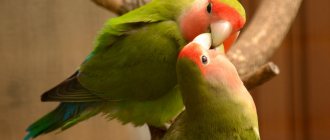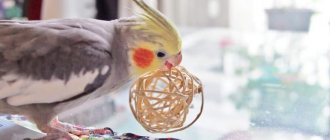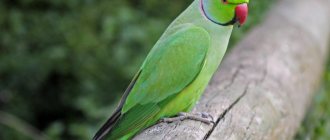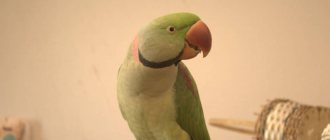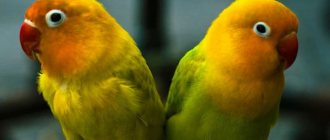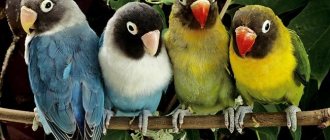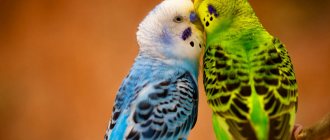The funny and inquisitive Corella parrot can become a loyal friend and family pet. But before purchasing a cockatiel, you need to learn everything about the features of keeping these parrots in the house.
One can only guess which other wild animals will be domesticated and tamed in the future by the king of nature - man. But we can say with one hundred percent certainty that parrots will not cease to be one of our favorite pets.
Particularly popular, along with budgerigars, are cockatiels or nymphs - funny birds from Australia with bright yellow, white or gray feathers and very pretty faces, if one can say so about parrots.
Photo of cockatiel parrots and nymph cockatiel
When they talk about cockatiels or nymphs, they mean the same parrots.
Yellow cockatiel parrot or nymph
Gray cockatiel parrots with yellow heads and orange cheeks
Full gray cockatiel parrot
How long do Corella parrots live at home?
When planning to purchase this cute and not particularly whimsical pet, the future owner is primarily interested in how many years the new family member will stay with him.
In natural conditions, cockatiels live no more than ten years, since they need to get their own food, which becomes difficult with age, and to escape from predators, which is also not always possible.
Under natural conditions, cockatiels live for about 10 years.
And in captivity, these birds feel quite comfortable and, with proper care, can live up to 18 years. There have been cases when cockatiels, thanks to the tireless care of their owners, lived up to 30 years.
At home, cockatiels live for about 18 years.
What needs to be done to make this pretty bird happy with its chirping for a very long time?
- Provide proper, high-quality and nutritious nutrition. Despite the fact that cockatiels are not at all picky about food, the grain must be of good quality, which can be checked by sprouting it. In addition to grains, the diet must include greens. You should also give plenty of fruit . And sweet, salty, fried and buttery foods should be prohibited and inaccessible to the parrot, as he can take advantage of your inattention and harm himself even with a small piece of bun. Thus, the cockatiel's diet should be as natural as possible.
- The place where the pet's cage is located must be protected from drafts and cold , since in these tropical birds the love for warmth is inherent at the genetic level. The most suitable temperature for them will be 20-25 degrees
- You can’t take risks by placing a cockatiel in a draft even for a few minutes , arguing that you are hardening the parrot, as this will greatly affect its health and, accordingly, its life expectancy
- In winter, when central heating dries out the air, it is necessary to provide optimal humidity for the pet - 55-60% , which, by the way, is very useful for the owner himself
- Cockatiels are also very sensitive to various foreign odors: tobacco, perfumes, air fresheners, and disinfectants should be used away from the bird’s location , as they can cause irreparable harm to the pet’s health
- The cockatiel should not be allowed to get into stressful situations . These parrots are very sociable and enjoy communicating with people, but at the same time they cannot tolerate sharp and loud sounds. You need to talk to them sincerely; calling them by name and frequent praise will have a positive effect on their well-being, and loneliness and inattention are like death for them
- Also, if the birds have a narrow cage, or there is a shortage of toys , this can also lead to stress.
- there is a small child in the house , you need to keep his communication with the pet under control, since the baby can unwittingly scare the parrot with loud sounds.
Always supervise the interaction between your child and your cockatiel.
So, if a Corella parrot falls into caring hands, it is guaranteed a long and happy life.
Where does the cockatiel live?
Photo: Corella in Australia
In nature, they live only on one continent - Australia, whose climate is ideal for them, and there are relatively few predators for which these small parrots serve as prey. Flying away domestic cockatiels on other continents are not adapted to life in nature and die.
First of all, this applies to those pets that were kept in the temperate zone - they are very demanding of the climate and are not able to survive even the autumn or spring cold, not to mention winter. But even if they fly free in a warm climate, they are quickly caught by birds of prey.
In Australia, they are practically never found near the coast: they prefer to live inland in an arid climate. However, it is not so rare to settle near the shores of lakes or rivers. But most often they live in grassy steppes, on large bushes, trees, and rocks overgrown with vegetation. Found in semi-deserts.
They love space and open areas, so they do not go deep into forests, but they can also settle on the edges of eucalyptus groves. If the year turns out to be dry, they gather near remaining bodies of water. Many cockatiels live in captivity, where they actively breed. They like to keep these parrots in North America, Europe, and Russia; they can also be found in Asian countries. There are such a large number of them in captivity that it is difficult to say where there are more of them - in nature or in humans.
How to find out how old a cockatiel parrot is?
Experts say that it is better to get a cockatiel between the ages of two and three months , because that is when they adapt most quickly to a new environment.
The young cockatiel will quickly get used to the new environment
To purchase a young parrot, when determining the age of a cockatiel, you need to pay attention not to size, because both young birds and adults are the same, but to the color of feathers, eyes, beak and behavior in general :
- At a young age, the color of these parrots is not very bright, even a little dull, the feathers on the tail are short, tousled and not the first freshness, since young birds do not yet know how to properly “beautify”: during cleaning they sit not on the perch, but on the bottom cage and, having cleaned themselves, immediately get dirty in their droppings. Also, in young animals there is a bald patch on the top of the head , which disappears after the first moult
- If the feathered pet is gray, then in young animals the beak and legs will be a soft pink hue, and in adults they have a darker and more saturated color
- You should also pay attention to the claws, which in young birds are light and soft
- Cockatiels of a different color have a smooth, peel-free beak that speaks of their youth.
- The eyes of adult cockatiels , in contrast to the paws and beak, are much lighter than those of young parrots : at first the iris of the eye is almost black, over time it acquires a light brown color, that is, it seems to fade in old age
- Even young birds cannot boast of a chic crest, since in young birds you can count only a few feathers in it , and they are not bent forward, like in seasoned birds, but grow straight
- If you pay attention to the behavior of birds, you will notice that young animals are characterized by clumsiness and clumsiness
Cockatiel chick
Natural enemies of cockatiels
Photo: Female Corella parrot
Australia doesn't have many predators, but it's mostly on the ground - many native birds even preferred to walk rather than fly. For such small birds as cockatiels, there are still a lot of dangers in the sky: they are hunted primarily by birds of prey, such as the black kite and the whistling kite, the Hobby, and the brown hawk.
Parrots are significantly inferior to birds of prey in flight speed and are not able to escape from them if they have already targeted them as prey. They are also inferior in the acuity of their senses, so they can only rely on mass numbers - a single cockatiel very quickly becomes the prey of a predator, it is unable to defend itself or fly away.
In a large flock, parrots scatter in all directions, the predator grabs one and usually stops there. At the same time, cockatiels cannot be called fearful: they usually sit on the branches of trees or bushes, open to attack, and can even go down, where they are vulnerable to ground predators. They are also not averse to eating them, because it is much easier to catch cockatiels than more cautious birds. People also sometimes take advantage of the serenity of these parrots: they are hunted for captivity and then sold, or for meat - even if it is not much, it is tasty, and it is very easy to get close to this bird.
The hunters simply approach, trying not to scare off the cockatiel - sometimes, even after seeing them, she remains in place and allows herself to be grabbed. And even if it takes off, it may soon return - because of this nature, many cockatiels suffer, but thanks to it, they make good pets.
Interesting fact: While cockatiels are usually not shy, they become very cautious near water bodies - there they face many dangers, and therefore they never sit down next to them to drink water. Instead, they descend vertically straight to the water, quickly swallow and immediately take off again. Usually they need several visits, after which they immediately fly away from the reservoir.
Corella parrot care, what kind of cage does a corella parrot need?
Nymphs love space, so you need to purchase a cage large enough.
Cockatiels love to move freely around rooms
IMPORTANT: If it is not possible to buy a spacious cage for your cockatiel, then every day, in order not to harm the pet’s health, you need to let it fly.
Basic requirements for a cockatiel cage:
- the rods should not be metal and located at a distance of 1.5-2 cm
- The door is spacious so that when pulling it out you don’t injure your pet
- There should be as few wooden elements in the cockatiel’s home as possible, since they absolutely love to peck at something all the time
- the cage must have perches, a rocker, a feeder and a drinker
- for entertainment, you need to put a mirror, bell or other toy in the cage
- These parrots take care of their hygiene, so at least once a week (every other day in summer) you need to put on a bathing suit, which must be removed immediately after the bathing procedure is completed.
IMPORTANT: You need to clean the cage every day, so for your convenience and the peace of mind of your pet, it is better to choose a home with a retractable tray. The perches should be cleaned with a brush or sandpaper. The water needs to be changed every day, after washing the drinking bowl.
To keep cockatiels you will need a spacious, equipped cage.
Walk
Like other types of parrots, regular walks are absolutely necessary for the cockatiel. When letting a bird fly around the room, you need to follow safety precautions. All other pets must be removed from the premises immediately. Windows and doors should be closed to prevent birds from flying out or a cat or dog from entering the room.
It is advisable to cover the mirrors with some kind of fabric so that the bird does not accidentally dive on them. Plants can also be removed from the room so that the parrot does not peck at them. The duration of the walk should be approximately 1-3 hours. While the parrot is walking, you can clean the cage.
When the parrot flies around the room, you need to carefully monitor it.
What to feed your cockatiel parrot?
Your feathered pet's diet should consist of high-quality grass seeds and plant grains, fresh fruits and vegetables; you can give dandelion and celery leaves.
Cottage cheese, eggs and nuts in small quantities are welcome It is advisable to put fresh branches of birch, rowan, and cherry in the cage. The parrot's food should be rich in proteins and amino acids.
IMPORTANT: The daily food intake is from 40 to 50 g, depending on the age and size of the cockatiel.
It is necessary to provide your cockatiel with adequate nutrition.
Do cockatiels speak and how to teach a cockatiel parrot to speak and sing songs?
As the heroine of Liya Akhidzhakova said in “Office Romance,” “you can teach a hare to smoke,” but teaching a smart cockatiel to talk is even easier.
The main thing is to start as early as possible and not buy a pair for him, because then they will talk to each other “in their own language.”
To make a cockatiel talk, you can't buy him a pair.
First you need to let the bird get used to the owner and his hands, while talking to her all the time. There should be only one teacher, so you need to include 40-45 minutes of daily training in your schedule, possibly with breaks.
Corella needs to get used to his owner's hands
Classes should take place in a calm environment where there are no extraneous sounds. The pet must be in a cage during lessons.
You need to start with simple phrases, such as “Kesha is good”, “Kesha is beautiful”, “Hello”, “How are you”. The abundance of sonorant and sibilant consonants, as well as the vowels “a” and “o” makes the task easier, because it is easier for the parrot to pronounce them.
The phrase must be constantly repeated, addressing the pet directly, until the result is achieved.
Before speaking, the cockatiel listens carefully to the words of the owner
Intonation should not change when repeated many times. You can constantly accompany the actions performed by the parrot with comments, such as “ Kesha is eating”, “Kesha is bathing” , then the conversation will seem meaningful. After moving on to the next phrase, you need to regularly repeat what you have already learned.
To make your parrot sing, you can record songs on a disc and let him listen to them several times a day. This will soon bear fruit and the cockatiel will give small concerts.
Cockatiels are happy to make contact and learn poems and songs with their owner
Care and feeding of a parrot
You should only release the parrot after it has settled in, otherwise it may not return to the cage on its own because it simply won’t find it. You cannot drive a bird into his house; he must fly there himself to eat and drink. The parrot must spend the night in a cage. If you need to go to bed and it is still flying, you can catch it with a net or a rag, and then pick it up. Make sure there are plenty of perches and ladders in the cage. After some time, the parrot will get used to you and will start jumping on your hand as soon as you offer him something tasty. Cockatiels are undemanding, but they are considered conservative - they are wary of unfamiliar food. You can offer them grain mixtures, wheat, seeds, corn, crushed nuts, oats. Parrots also eat cabbage, carrots, cucumbers, cherries, plums, and apricots.
Corellas love to swim. For this they are called nymph parrots. In nature, they like to spin around waterfalls in the mist of fine spray. To please your pets, you can take a spray bottle of clean water and spray it on your parrots. They really like it - the cockatiels fluff up their feathers and are very happy about this “rain”.
Why does the Corella parrot scream, tremble, hiss, and pluck its feathers?
Such actions of a parrot are typical if it is experiencing stress . It often happens that, having acquired a pet, the owners do not allow the bird to get used to the new environment, but begin to stick their hand into the cage, thinking that this way it will adapt faster.
However, the cockatiel perceives these actions as a threat and begins to scream and hiss, hoping to scare the uninvited guest, while shaking and plucking feathers indicates an extreme form of excitement.
Therefore, in order not to give your parrot a heart attack, you need to gradually tame it: first to your presence next to the cage, then to your voice, let it out more often and talk all the time.
When stressed, a cockatiel may tremble, hiss, or pull out its feathers.
Communication and training
How to quickly tame a cockatiel? The main rule here is regularity and gradualness. You can’t try to put a parrot on your hand right away. He will simply get scared and show aggression. You must gradually, every day, bring your hand closer to the bird. He must get used to it and not feel danger from the owner. In order for a parrot to jump onto your hand, it must contain his favorite food. Once the parrot is completely tamed, you can begin to teach it to speak.
Regularity and gradualness are also important in teaching speech. You need to start with the simplest words, which contain the vowels o and a. After the pet has mastered them, you need to move on to more complex words, and then to phrases. During lessons there should be a friendly atmosphere. The use of punishment and violence against a pet is unacceptable. The optimal duration of classes is 15-25 minutes, but they should take place every day. If these conditions are met, the cockatiel will learn to speak quite well.
How to determine the sex of a cockatiel parrot, how to distinguish a male from a female?
For such a delicate matter, you first need to classify cockatiels according to color and conditionally divide them into two groups:
- The first category includes parrots of gray or a color close to it, that is, natural
- to the second - all the rest
Female cockatiel of natural color
Now you can start classifying gender.
In the first group:
- The heads of males have a fairly rich yellow color and bright orange cheeks, while females have a more modest color of the head, in which gray is still dominant.
- The tip of the tail of the female is spade-shaped, rounded at the bottom , while the tip of the male is thin and sharp.
- If you carefully examine the inner side of the wings of a feathered pet, then in females you can find light oval spots there, and on the inner tail feathers there are dark stripes of a dark color
But all these differences will be visible only after the first molt, which occurs after 6 months of life, and before that, both boys and girls are colored exactly the same.
The sex of cockatiels belonging to the second color group can be determined only by behavior, although the patterns described above on the inside of the tail and wings are slightly noticeable upon very close inspection.
True, there are several more external signs that can help in determining the sex of a parrot:
- females are slightly larger than males
- The female's crest is less dense at the base, and the forehead is narrower
- the female is more restrained in behavior, and the male often frolics and jumps on two legs
- the male chirps and sings a lot
- if a cockatiel parrot laid an egg, then it is naturally a female
Male cockatiels are more active, curious and sociable than females
IMPORTANT: There are exceptions to all rules and it is better to let a specialist determine the sex, having previously passed the appropriate tests: a pen, a cloacal wash, or a DNA test.
Appearance and features
Photo: Corella
Corella is not a large parrot; it reaches 30-35 centimeters in length, half of which is the tail. Weighs from 80 to 150 grams. The tail generally stands out - it is long and pointed. Another sign is a high crest; it can be raised or lowered, it depends on the mood of the bird.
The plumage is brighter in males. Their head and crest are colored yellow, orange spots stand out on their cheeks, and their body and tail are olive and gray. In females, both the head and crest are gray, as is the body itself, but it is darker, especially below - the tone can reach brown.
The spots on their cheeks are not orange, but brown. They are also distinguished by pale yellow spots and stripes on the flight and tail feathers - these are absent in males. The cockatiel's beak is short. Young parrots all look like females, so identifying males is quite difficult.
Only closer to a year after the birth of the cockatiel do they resemble adults in color. Before that, males can only be identified by their behavior: they are usually more active, louder - they like to sing and bang on the cage, and they grow faster. Females, on the other hand, are calm.
The color that cockatiels had in nature is described above; many others have been bred in captivity, for example, white and pearl-colored pets, black, motley black-gray, and others are common.
Interesting fact: These parrots love to fly, and therefore, when kept in captivity, they must either be released from the cage so that they can fly around the apartment, or placed in a spacious cage so that they can do this right inside.
Features of keeping Corella parrots boy and girl
When purchasing a mixed-sex pair, it is important to understand that this will eventually lead to the appearance of chicks. Therefore, first you need to properly equip the place where the parrots are kept.
First, you need to purchase not an ordinary cage, but a so-called cage, which has a flat roof and a hole on one of the walls, except the front one, so that when the time comes to hang the nesting device.
In the nymphs' home, the length of the cage should be twice as wide as the width, so that when flying from perch to perch, muscles are strengthened and metabolism is improved, which will have a positive effect on the health of the offspring.
A mixed-sex pair of cockatiels will quickly have offspring
Parrot selection and taming
If you decide that a nymph is the most desirable pet for you, try to buy it in a specialized nursery, where there are all the conditions for breeding and raising young animals. Most pet stores cannot provide good temporary housing conditions for birds.
When choosing a cockatiel, you need to focus on the following parameters:
- if you want your parrot to quickly get used to you and become tame, choose a young bird, 1 month old;
- inspect the plumage of the cockatiel, it should be neat, without kinks, the feathers fit tightly to each other;
- there should be no growths or cracks on the beak;
- eyes are clear, shiny, without discharge;
- the cloaca is clean, without dirty feathers around;
- a young and healthy cockatiel is an active, inquisitive and cheerful bird, but a silent and ruffled parrot sitting motionless on a perch is an alarming signal, the bird is either old or has some kind of disease.
About the difficulties you may encounter when choosing a parrot, as well as the disadvantages of keeping cockatiels at home, watch this video:
How to name cockatiels, how to come up with names?
If you plan to find an interlocutor in a parrot in the future, then his name should be short, laconic, contain hissing sounds and a sonorant “r”: Kesha, Gosha, Petrusha, Bisha, Shura, Rashik, Lusha, Krosh, Glasha .
If there are problems determining gender, then the nickname should be “unisex”: Chucha, Eshka, Roni .
Also, the chosen name should not be similar to the names of other pets or family members.
You can choose a name taking into account the character traits and demeanor of your feathered friend: Shurshik, Lucky, Sheiki .
Corella parrot loves to say its name
Intelligence and habits
Among breeders, the Corella parrot is famous for its good nature; they say about it: “affectionate, like a house cat.” They are smart, easy to tame and train, and can learn several dozen human words. True, these birds do not have outstanding vocal abilities: you should not expect clear pronunciation from them. The nymph is able to imitate animals and imitate the noise of operating equipment. In a state of highest pleasure, the parrot sings, whistles in every way, and goes through words from its stock.
Important: Often, a talkative cockatiel with its harsh voice arouses hostility among others. A frightened or angry bird makes very unpleasant, ear-piercing sounds.
The character of a cockatiel is a variable value. A change in behavior may be due to the introduction of a new bird, illness, or the awakening of the sexual instinct. Do not give in to the reciprocal desire to intimidate, shout, or push the bird away. Only with patience and affection can you regain her trust.
When getting a cockatiel, be prepared for the fact that it needs to be raised. An adult that remembers the previous owner has difficulty getting used to its new habitat. The established character and habits of such a parrot cannot be corrected. If you take home a three-month-old chick, it is quite easy to raise an obedient and intelligent pet from it. You just need to work with him from the first day, once the adaptation process is over. A mischievous nymph who trusts her owner is most willing to talk and perform tricks.
The demand for cute parrots is not decreasing - they captivate with their gentle appearance, flexible mind, and calm temperament. It is easy to achieve reciprocity from them if you show goodwill and surround them with care and attention. The best living conditions will help the bird become a full member of the family.
Corella parrot disease treatment
Cockatiels, in fact, like other pets, have quite a lot of diseases.
IMPORTANT: When a parrot’s respiratory process is disrupted, signs of distress appear, lack of appetite, feather loss, then this is a reason to immediately seek help from a veterinarian, who will make the correct diagnosis and prescribe treatment.
Let's look at the most common types of cockatiel ailments:
- Various eye diseases characterized by inflammatory processes in the periocular space. This could be conjunctivitis, a foreign body, or some kind of infection . Treatment of these diseases consists of washing the eyes with either a solution of boric acid (one teaspoon per glass of water) or furatsilin (1 tablet per glass of water)
- Various goiter diseases resulting from poor nutrition. Symptoms manifest themselves in the form of loose stools and inflammation of the goiter . For recovery, it is urgent to remove toxins from the body by giving the parrot activated charcoal.
- Feather loss is associated, in most cases, with scheduled molting, which occurs every six months. In this case, the feathers fall out unevenly, and bald patches may form. This process is characterized by an increase in body temperature . If the temperature is normal, and the feathers fall out of the tail especially abundantly, then this may indicate a stressful situation in which the cockatiel is. When molting is accompanied by wounds and restless behavior of the parrot, this is a clear sign of the presence of parasites or bacteria, which need to be treated with special ointments
- It happens that a parrot, very active and independent, ended up in a draft zone for some time, and, as a result, caught a cold . The symptoms, in this case, are very pronounced: there is no appetite, the eyelids are red, the nose is running, the voice has changed , in general, everything is like in people. For treatment you need to be patient, as only good care and increased vitamin supplementation will help your pet get better
Eye infection in cockatiel
The cockatiel parrot laid an egg: what to do?
First of all, be happy, because cockatiels think about their offspring when everything is good for them: food, water, air, sun - everything is there and there is nothing to worry about.
But it is still important to understand:
- The bird has reached reproductive age and is ready to reproduce. If you are not interested in increasing the number of birds , then it is better to immediately take this egg, like all subsequent ones. The young mother, of course, will not like this, but, as they say, time heals and puts everything in its place. The laying will stop over time
- If breeding is planned , then the female must sit on the eggs for the prescribed 2.5-3 weeks to practice. If you are afraid that they will spoil, you can replace them with plastic simulators. As a result of this, the female will be mentally calm and will acquire the necessary skills later.
Corella laid eggs
How to tame a cockatiel parrot?
It is very easy to tame a cockatiel, which has an extraordinary mind and ingenuity, if you follow some recommendations:
- train a young individual, because the older the parrot, the more difficult the training, and with older birds it is completely pointless
- It is necessary to establish a trusting relationship with the pet, which ensures the absence of fear in the parrot
- Stay near him often and for a long time , without claiming his territory
- Use approved treats for hand feeding
- Use toys : Curious cockatiels won't be able to resist a string of beads or a shiny, jingling bell.
Cockatiels quickly get used to the hands of their owner.
The main thing is desire and patience, and then everything will work out.
When purchasing a cockatiel parrot, remember that these are very sociable birds. Waking up at dawn, they wake up everyone in the household with their loud, demanding cry, calling for communication.
If you like to sleep longer, think carefully about whether you are ready for the changes in your life and schedule that will definitely happen as soon as a little feathered miracle with a crest appears in your house.
Reproduction
In nature, the nesting cycles of the cockatiel depend on the rainy season. This is due to the fact that it is easier to raise chicks when there is an abundance of water. All species of cockatiels breed twice a year: the first clutch is usually incubated in the fall, the second in mid-winter. The female lays five to seven eggs, which are incubated alternately with the male for 21 to 23 days. The parents feed the hatched chicks until they are approximately two months old, then the older generation leaves the nest. Having rested, the couple begins a new laying.
Corella parrot chick
A married pair of tame parrots can reproduce freely if favorable conditions are created:
- closer to autumn (or spring, if this time of year is chosen), you should start feeding the birds with a special vitamin mixture;
- add sprouted grains and calcium to food;
- gradually increase daylight hours to 16 hours;
- You need to prepare a nest box (house) in the cage.
Individuals must be at least two years old and not older than six years old. Inbreeding is undesirable, otherwise you may end up with defective, sick chicks with defects.
